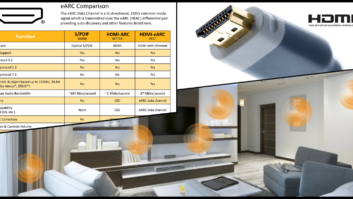NEW YORK — The high-resolution audio business is getting higher.
The selection of high-resolution music is growing, mainstream download sites have taken notice of highresolution audio’s growth, and the growth of high-end headphones for mobile use will encourage high-res music listening on mobile devices because they let consumers hear the difference, music-industry executives said at a seminar, here, during CE Week.
On top of that, the music and consumer electronics industries have agreed on a standardized definition of high-resolution audio to promote to consumers, although they haven’t decided yet on a single logo or definitions of high-res audio playback devices.
In addition, multiple companies have unveiled new audio components and networked-audio speakers that support multiple high-res codecs, and Sprint teamed up with HDtracks, the high-resolution music-download service, to offer a free music sampler to Sprint subscribers who own the LG G2 smartphone or the new Sprint-exclusive HTC One (M8) Harman Kardon edition. Both smartphones store and play back music files encoded in the lossless FLAC format with up to 192kHz/24-bit resolution.
Getting high-resolution DACs in mobile devices such as smartphones is key to expanding high-resolution audio beyond audiophiles to mainstream music lovers, music-industry executives said during a CE Week seminar.
“Our retailers today are focused on the audiophile market,” said Howie Singer, senior VP at Warner Music Group. But average consumers listen to music on their mobile devices, he said.
Jim Belcher, technology and production VP at Universal Music Group, agreed that “PCs are fading as consumption devices” among consumers, and he expects high-resolution audio chips in smartphones “will encourage a lot of people” to listen to high-res music. Major music-download sites will be more interested in selling high-resolution music downloads as soon as high-resolution chipsets are available in “the large majority of phones,” he said.
Big retailers have not “formally” indicated an interest in selling UMG’s high-resolution music, Belcher noted, but “it’s on their radar.”
Although high-resolution music downloads are in their infancy, Belcher said UMW is “encouraged” by sales so far.
Warner’s Singer is also encouraged by sales so far. Warner offers only a limited catalog through several retailers, and they are delivering “good performance relative to the catalog size.”
The music companies acknowledge, however, that it has been a challenge to deliver high-res files to online stores, but the challenges are fading.
To help consumers understand what they are buying, the music and consumer electronics industries agreed on a standardized definition of high-resolution audio.
The industries also created voluntary descriptions for the four types of master source recordings, or Master Quality Recordings, that can be used to produce the high-res files available through digital music retailers.
The four categories and their descriptions are:
MQ-P: from a PCM master source that is 48kHz/20 bit or higher (typically 96/24 or 192/24 content);
MQ-A: from an analog master source;
MQ-C: from a CD master source (44.1 kHz/16 bit content) in which legacy CD masters are employed as source material and upsampled to high resolution; and
MQ-D: from a DSD/DSF master source (typically 2.8 or 5.6 MHz content).













